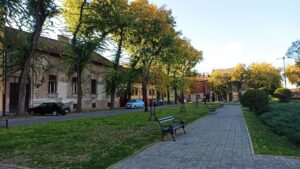Development of suburban construction in Subotica in recent years.
In recent years, Subotica, a city located in northern Serbia, has witnessed a significant transformation in its suburban construction landscape. This evolution is driven by various factors, including population growth, economic development, and changing lifestyle preferences. As urban areas become increasingly congested, many residents are seeking the tranquility and space that suburban living offers. This article explores the key developments in suburban construction in Subotica, examining the implications for the local economy, community, and environment.
Growth in Demand for Suburban Living
The demand for suburban living in Subotica has surged in recent years, largely fueled by a growing population and an influx of families seeking more spacious accommodations. As urban centers become more crowded, many residents are opting to relocate to the suburbs, where they can enjoy larger homes and access to green spaces. This trend has prompted developers to invest in new residential projects that cater to the needs of families, young professionals, and retirees alike.
In response to this demand, various housing developments have emerged in the suburban areas surrounding Subotica. These projects range from single-family homes to multi-unit residential complexes, providing a diverse array of options for potential buyers. The construction of these new homes not only addresses the housing shortage but also contributes to the overall economic growth of the region, creating jobs and stimulating local businesses.
Moreover, the shift towards suburban living has been accompanied by a growing interest in sustainable construction practices. Many developers are now incorporating eco-friendly materials and energy-efficient designs into their projects, reflecting a broader societal trend towards environmental consciousness. This focus on sustainability not only enhances the appeal of suburban homes but also aligns with the values of an increasingly eco-aware population.
Infrastructure Development and Urban Planning
As suburban construction in Subotica expands, the need for improved infrastructure has become increasingly apparent. Local authorities are recognizing the importance of investing in transportation, utilities, and public services to support the growing suburban population. This includes the development of new roads, public transit options, and enhanced utility services, which are essential for ensuring that suburban residents have access to the amenities they need.
Urban planning has also evolved to accommodate the changing landscape of Subotica. City planners are working to create cohesive suburban communities that prioritize walkability, green spaces, and community engagement. This approach not only enhances the quality of life for residents but also fosters a sense of belonging and community spirit. By integrating parks, recreational facilities, and commercial areas into suburban developments, planners are striving to create vibrant neighborhoods that cater to a diverse range of lifestyles.
Additionally, the collaboration between local government and private developers has become crucial in shaping the future of suburban construction in Subotica. By working together, these stakeholders can ensure that new developments align with the city’s long-term vision and address the needs of its residents. This collaborative approach is essential for creating sustainable, livable communities that can thrive in the years to come.
Economic Impacts of Suburban Construction
The recent boom in suburban construction in Subotica has had a profound impact on the local economy. As new residential projects are developed, they generate significant economic activity, from the construction phase to the eventual sale of homes. This influx of investment not only creates jobs in the construction sector but also stimulates demand for goods and services in the surrounding area, benefiting local businesses.
Moreover, the growth of suburban neighborhoods has led to an increase in property values, which can have positive implications for the city’s tax base. Higher property values translate into increased revenue for local governments, enabling them to invest in essential services and infrastructure improvements. This financial boost can help Subotica enhance its public amenities, such as schools, parks, and transportation systems, ultimately benefiting all residents.
However, the rapid development of suburban areas also presents challenges, including the potential for urban sprawl and the strain on existing infrastructure. Local authorities must carefully manage growth to ensure that it remains sustainable and does not compromise the quality of life for residents. By balancing development with responsible urban planning, Subotica can harness the economic benefits of suburban construction while mitigating its potential downsides.
In conclusion, the development of suburban construction in Subotica over recent years reflects a broader trend towards suburban living, driven by changing demographics and lifestyle preferences. As the city continues to grow, the focus on sustainable development, infrastructure improvement, and economic impact will be crucial in shaping the future of its suburban areas. By fostering collaboration between stakeholders and prioritizing community needs, Subotica can create vibrant, sustainable neighborhoods that enhance the quality of life for all its residents.


